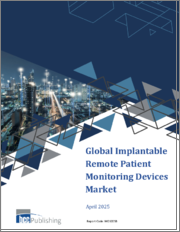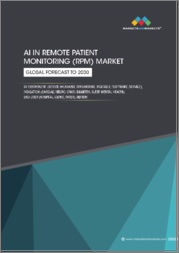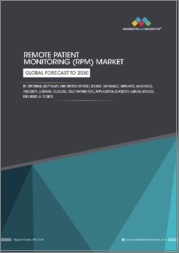
|
시장보고서
상품코드
1542931
세계의 원격 모니터링 웨어러블 시장(2024-2031년)Global Remote Monitoring Wearables Market - 2024-2031 |
||||||
리포트 개요
세계의 원격 모니터링 웨어러블 시장은 2023년에 54억 달러에 달하며, 2031년에는 151억 달러에 달하며, 예측 기간인 2024-2031년 CAGR은 14.1%로 성장할 것으로 예측됩니다.
원격 모니터링 웨어러블 기능은 사용자가 제공하는 건강 데이터를 수집하여 개인 건강 용도 또는 의료 종사자에게 전송하도록 설계된 기술 가젯입니다. 이러한 가젯은 다양한 생리적 매개 변수를 지속적으로 추적하여 사용자가 건강을 위한 예방 조치를 취할 수 있도록 도와줍니다.
웨어러블은 블루투스나 와이파이를 통해 스마트폰이나 클라우드로 연결하여 의료진이나 건강 용도과 실시간으로 데이터를 공유할 수 있습니다. 원격 환자 모니터링용 웨어러블은 원격의료 플랫폼과 쉽게 통합할 수 있으며, 의료 전문가는 멀리 떨어진 곳에서 환자를 관찰하고 치료 요법을 실시간으로 수정할 수 있습니다.
시장 역학 :
촉진요인과 억제요인
만성질환의 유병률 증가
만성질환의 유병률 증가는 시장 성장을 가속할 것으로 예상됩니다. 당뇨병, 고혈압, 심혈관 질환과 같은 만성질환은 증상을 적절히 관리하기 위해 지속적인 건강 모니터링이 필요합니다. 원격 모니터링 기능을 갖춘 웨어러블을 통해 환자는 자신의 건강 지표와 활력 징후를 실시간으로 추적할 수 있으며, 증상 관리를 개선할 수 있습니다.
만성질환의 유병률이 증가함에 따라 환자의 건강 상태를 관리하고 증상을 관리하는 의료 서비스 프로바이더가 증가할 것으로 예상됩니다.
예를 들어 2023년 6월 워싱턴대학의 Institute for Health Metrics and Evaluation의 발표에 따르면 전 세계 5억 명 이상이 당뇨병을 앓고 있으며, 모든 국가의 모든 연령대의 남성, 여성, 어린이에게 영향을 미치고 있다고 한다, 향후 30년간 그 수가 2배 이상 증가한 13억 명에 달할 것으로 예측했습니다.
웨어러블은 환자와 의료진이 최신 데이터에 접근할 수 있도록 함으로써 만성질환에 대한 예방적 대처를 용이하게 합니다. 이를 통해 발생할 수 있는 문제를 조기에 발견하고 적시에 대처할 수 있으며, 입원 횟수를 줄일 수 있습니다.
노년층의 기술 도입이 늦어지고 있습니다.
기술과 스마트 기기에 익숙하지 않은 것은 많은 잠재적 사용자, 특히 노년층이 직면할 수 있는 문제입니다. 이러한 불편함은 웨어러블 기술의 채택을 방해할 수 있으며, 건강 모니터링 능력을 떨어뜨릴 수 있습니다. 원격 모니터링용 웨어러블은 사용자가 그 효과와 정확성을 의심하게 만들 수 있습니다. 건강 상태의 결과에 명백한 이점이나 개선이 보이지 않으면 사용자는 이러한 가젯을 채택하는 것을 주저할 수 있습니다.
시장 부문 분석
세계 원격 모니터링 웨어러블 시장은 기기 유형, 질병, 기능, 최종사용자, 지역별로 분류됩니다.
스마트워치와 피트니스 트래커 부문이 시장 점유율을 독식할 것으로 전망
스마트워치와 피트니스 트래커 부문이 시장 점유율에서 주요 위치를 차지할 것으로 예상됩니다. 최근 수년간 피트니스 트래커와 스마트 워치가 확대되고 있습니다. 손목에 착용하는 이 우아한 가젯은 사용자가 다양한 건강 지표를 모니터링할 수 있는 기능과 센서를 갖추고 있습니다.
심박수, 수면 패턴, 스트레스 수준 및 일상적인 신체 활동을 모니터링하기 위해 의사는 종종 스마트 워치 또는 피트니스 트래커를 권장합니다. 또한 이러한 장비 중 일부는 심전도 모니터링과 같은 기능을 가지고 있으며, 가능한 심장 문제나 비정상적인 심장 리듬을 식별하는 데 사용할 수 있습니다.
기술의 발전과 함께 환자나 의료진이 편안하게 사용할 수 있는 첨단 기기의 출시가 늘어남에 따라 이 분야의 성장이 가속화될 것으로 예상됩니다.
예를 들어 2024년 7월 사물인터넷(IoT) 기업 KORE는 mCareWatch 241이라는 가상 환자 모니터링용 스마트 워치 출시를 발표했습니다. 이 시계는 SOS 설정, 통화 기능, GPS 추적, 알림, 알림, 심박수 모니터, 단축 다이얼, 낙상 감지, 만보계, 지오펜스 알람, 비동작 감지, 모바일 앱 및 웹 대시보드, 긴급 지원을 받을 수 있는 SOS 설정, 통화 기능 등을 갖추고 있습니다.
또한 2024년 7월 12일, 삼성은 스마트폰 및 스마트워치와 엔드투엔드(end-to-end) 통합되어 24시간 365일 착용할 수 있는 화제의 신제품 갤럭시 링(Galaxy Ring)을 포함한 웨어러블 제품 라인업을 발표하였습니다. 이 가벼운 장비는 수면 패턴, 심박수 변화, 활동량 등 주요 건강 지표를 하루 24시간 지속적으로 모니터링하는 다양한 센서를 탑재하고 있습니다.
지역별 시장 분석
북미가 원격 모니터링 웨어러블 시장 점유율에서 중요한 위치를 차지할 것으로 전망
북미는 시장 점유율에서 중요한 위치를 차지하고 있습니다. 기술 발전, 만성질환의 유병률 증가, 개인 인식 증가로 인해 북미는 시장 점유율에서 중요한 위치를 차지하고 있습니다. 또한 이 지역에는 다수의 기기 제조업체가 존재하므로 이 지역이 시장 점유율에서 우위를 차지할 것으로 예상됩니다.
예를 들어 2023년 6월, STAT Health는 기립시 발생하는 신체 상태를 더 잘 이해할 수 있도록 머리의 혈류를 측정하는 24시간 365일 착용할 수 있는 귀걸이형 웨어러블 종합 웰니스 제품을 발표했습니다.
또한 2022년 11월, 원격 재활을 위한 원격 환자 모니터링 웨어러블 솔루션 개발 기업인 센소리아 헬스(Sensoria Health)는 최초의 진정한 웨어러블 원격 재활 플랫폼을 발표했습니다. 센소리아는 환자 중심의 멀티 디바이스 모바일 및 클라우드 소프트웨어 원격 재활 시스템을 제공하여 물리치료사 및 임상의가 환자 집단의 가장 흔한 상태를 쉽고 효율적으로 원격 모니터링할 수 있도록 지원합니다.
목차
제1장 조사 방법과 조사 범위
제2장 정의와 개요
제3장 개요
제4장 시장 역학
- 영향요인
- 촉진요인
- 만성질환의 증가
- 억제요인
- 고령자에 의한 기술 도입의 지연
- 기회
- 영향 분석
- 촉진요인
제5장 산업 분석
- Porter's Five Forces 분석
- 공급망 분석
- 가격 분석
- 규제 분석
- 상환 분석
- 특허 분석
- SWOT 분석
- DMI 의견
제6장 디바이스 유형별
- 스마트워치와 피트니스 트래커
- 연속 혈당 모니터(CGM)
- 웨어러블 ECG 모니터
- 원격 모니터링 패치
- 기타
제7장 질환별
- 심혈관질환
- 천식
- 알츠하이머병
- 신장 질환
- 기타
제8장 기능별
- 심박 트래킹
- ECG(심전도)
- 혈중 산소 농도(SpO2) 모니터링
- 수면 질 모니터링
- 신체 활동 모니터링
- 기타
제9장 최종사용자별
- 병원
- 진료소
- 기타
제10장 지역별
- 북미
- 미국
- 캐나다
- 멕시코
- 유럽
- 독일
- 영국
- 프랑스
- 이탈리아
- 스페인
- 기타 유럽
- 남미
- 브라질
- 아르헨티나
- 기타 남미
- 아시아태평양
- 중국
- 인도
- 일본
- 한국
- 기타 아시아태평양
- 중동 및 아프리카
제11장 경쟁 구도
- 경쟁 시나리오
- 시장 현황/점유율 분석
- M&A 분석
제12장 기업 개요
- MedIoTek Health Systems
- 회사 개요
- 제품 포트폴리오와 설명
- 재무 개요
- 주요 발전
- BioIntelliSense, Inc.
- Apple Inc.
- AliveCor India
- Koninklijke Philips N.V.,
- Garmin Ltd.
- Samsung Health
- Biobeat
- Qardio, Inc.
- Fitbit(*LIST NOT EXHAUSTIVE)
제13장 부록
KSA 24.09.06Report Overview
Global Remote Monitoring Wearables Market reached US$ 5.4 billion in 2023 and is expected to reach US$ 15.1 billion by 2031, growing at a CAGR of 14.1% during the forecast period 2024-2031.
Remote monitoring wearables capabilities are technological gadgets designed to gather and send user-provided health data to personal health applications or healthcare practitioners. These gadgets provide the continuous tracking of numerous physiological parameters, assisting users in taking preventative measures for their health.
Wearables can share real-time data with healthcare practitioners or health apps by connecting to smartphones or the cloud via Bluetooth or Wi-Fi. Wearables for remote patient monitoring can easily be integrated with telehealth platforms, giving medical professionals the ability to watch patients from a distance and modify treatment regimens in real-time.
Market Dynamics: Drivers & Restraints
Increasing prevalence of chronic diseases
The rising prevalence of chronic diseases is expected to drive the market growth. To properly manage symptoms, chronic disorders like diabetes, hypertension, and cardiovascular issues require continual health monitoring. Wearables with remote monitoring allow patients to track their health measures and vital signs in real time, improving the management of their conditions.
The prevalence of chronic diseases is increasing, this is expected to increase healthcare providers to manage their patient's health conditions and manage their symptoms.
For instance, in June 2023, the Institute for Health Metrics and Evaluation of the University of Washington stated that more than half a billion people are living with diabetes worldwide, affecting men, women, and children of all ages in every country, and that number is projected to more than double to 1.3 billion people in the next 30 years.
By giving patients and medical professionals access to up-to-date data, wearables facilitate the proactive handling of chronic diseases. This makes it possible to detect possible problems at an early stage, allowing timely action and lowering the number of hospital admissions.
Lack of adoption of technology by elderly people
The lack of familiarity with technology and smart gadgets may be faced by many potential users, elderly people in particular. Wearable technology adoption can be hampered by this discomfort, which would reduce its ability to monitor health. Wearables for remote monitoring can lead users to doubt their efficacy and precision. Users may be hesitant to adopt these gadgets if they don't see an obvious benefit or improvement in their health results.
Market Segment Analysis
The global remote monitoring wearables market is segmented based on device type, disease, function, end-user, and region.
The smartwatches and fitness trackers segment is expected to dominate the market share
The smartwatches and fitness trackers segment is expected to hold a major position in the market share. In recent years, fitness trackers and smartwatches have expanded. These elegant, wrist-worn gadgets are featured with functions and sensors that let users keep an eye on a variety of health indicators.
For monitoring heart rate, sleep patterns, stress levels, and everyday physical activity, doctors frequently recommend smartwatches and fitness trackers. Additionally, some of these devices have abilities like ECG monitoring, which can be used to identify possible cardiac problems and abnormal heart rhythms.
The rising advancements in technology and an increasing number of advanced devices by the companies that are comfortable to use by the patients and healthcare providers are expected to drive the segment growth.
For instance, in July 2024, KORE, an Internet of Things (IoT) company announced the launch of a smartwatch for virtual patient monitoring called mCareWatch 241. The watch features an SOS setting that enables wearers to obtain emergency assistance, call capabilities, GPS tracking, reminders, a heart rate monitor, speed dialing, fall detection, a pedometer, a geo-fence alarm, non-movement detection, and a mobile app and web dashboard.
Additionally, on July 12, 2024, Samsung unveiled its expanded slate of wearable products, including the highly-buzzed new Galaxy Ring that can be worn 24/7 with end-to-end integration with its smartphones and smartwatches. The lightweight device boasts a suite of sensors that continuously monitor key health metrics including sleep patterns, heart rate variability, and activity levels 24 hours a day.
Market Geographical Analysis
North America is expected to hold a significant position in the remote monitoring wearables market share
North America holds a significant position in the market share. The rising technological advancements, increasing prevalence of chronic diseases, and increasing awareness among individuals. The presence of a large number of device manufacturers in the region is also expected to hold the region in a dominant position in the market share.
For instance, in June 2023, STAT Health introduced a 24/7 in-ear wearable general wellness product that measures blood flow to the head to allow a better understanding of conditions in the body that occur upon standing.
Additionally, in November 2022, Sensoria Health, a developer of tele-rehab remote patient monitoring wearable solutions, introduced the first truly wearable telerehabilitation platform. Sensoria offers a patient-centric, multi-device mobile and cloud software tele-rehab system that makes it easy and efficient for physical therapists and clinicians to remotely monitor the most common conditions in their patient population.
Market Segmentation
By Device Type
- Smartwatches and Fitness Trackers
- Continuous Glucose Monitors (CGMs)
- Wearable ECG Monitors
- Remote Monitoring Patches
- Others
By Disease
- Cardiovascular Diseases
- Asthma
- Alzheimer Disease
- Kidney Diseases
- Others
By Function
- Heart Rate Tracking
- ECG (Electrocardiogram)
- Blood Oxygen Levels (SpO2) Monitoring
- Sleep Quality Monitoring
- Physical Activity Monitoring
- Others
By End-User
- Hospitals
- Clinics
- Others
By Region
- North America
- U.S.
- Canada
- Mexico
- Europe
- Germany
- UK
- France
- Italy
- Spain
- Rest of Europe
- South America
- Brazil
- Argentina
- Rest of South America
- Asia-Pacific
- China
- India
- Japan
- South Korea
- Rest of Asia-Pacific
- Middle East and Africa
Market Competitive Landscape
The major global players in the market include MedIoTek Health Systems, BioIntelliSense, Inc., Apple Inc., AliveCor India, Koninklijke Philips N.V., Garmin Ltd., Samsung Health, Biobeat, Qardio, Inc., and Fitbit among others.
Why Purchase the Report?
- To visualize the global remote monitoring wearables market segmentation based on device type, disease, function, end-user, and region as well as understand key commercial assets and players.
- Identify commercial opportunities by analyzing trends and co-development.
- Excel data sheet with numerous data points of remote monitoring wearables market-level with all segments.
- PDF report consists of a comprehensive analysis after exhaustive qualitative interviews and an in-depth study.
- Product mapping available as excel consisting of key products of all the major players.
The global remote monitoring wearables market report would provide approximately 53 tables, 47 figures, and 176 pages.
Target Audience 2024
- Manufacturers/ Buyers
- Industry Investors/Investment Bankers
- Research Professionals
- Emerging Companies
Table of Contents
1. Methodology and Scope
- 1.1. Research Methodology
- 1.2. Research Objective and Scope of the Report
2. Definition and Overview
3. Executive Summary
- 3.1. Snippet by Device Type
- 3.2. Snippet by Disease
- 3.3. Snippet by Function
- 3.4. Snippet by End-User
- 3.5. Snippet by Region
4. Dynamics
- 4.1. Impacting Factors
- 4.1.1. Drivers
- 4.1.1.1. Increasing prevalence of chronic diseases
- 4.1.2. Restraints
- 4.1.2.1. Lack of adoption of technology by elderly people
- 4.1.3. Opportunity
- 4.1.4. Impact Analysis
- 4.1.1. Drivers
5. Industry Analysis
- 5.1. Porter's Five Force Analysis
- 5.2. Supply Chain Analysis
- 5.3. Pricing Analysis
- 5.4. Regulatory Analysis
- 5.5. Reimbursement Analysis
- 5.6. Patent Analysis
- 5.7. SWOT Analysis
- 5.8. DMI Opinion
6. By Device Type
- 6.1. Introduction
- 6.1.1. Market Size Analysis and Y-o-Y Growth Analysis (%), By Device Type
- 6.1.2. Market Attractiveness Index, By Device Type
- 6.2. Smartwatches and Fitness Trackers *
- 6.2.1. Introduction
- 6.2.2. Market Size Analysis and Y-o-Y Growth Analysis (%)
- 6.3. Continuous Glucose Monitors (CGMs)
- 6.4. Wearable ECG Monitors
- 6.5. Remote Monitoring Patches
- 6.6. Others
7. By Disease
- 7.1. Introduction
- 7.1.1. Market Size Analysis and Y-o-Y Growth Analysis (%), By Disease
- 7.1.2. Market Attractiveness Index, By Disease
- 7.2. Cardiovascular Diseases*
- 7.2.1. Introduction
- 7.2.2. Market Size Analysis and Y-o-Y Growth Analysis (%)
- 7.3. Asthma
- 7.4. Alzheimer Disease
- 7.5. Kidney Diseases
- 7.6. Others
8. By Function
- 8.1. Introduction
- 8.1.1. Market Size Analysis and Y-o-Y Growth Analysis (%), By Function
- 8.1.2. Market Attractiveness Index, By Function
- 8.2. Heart Rate Tracking *
- 8.2.1. Introduction
- 8.2.2. Market Size Analysis and Y-o-Y Growth Analysis (%)
- 8.3. ECG (Electrocardiogram)
- 8.4. Blood Oxygen Levels (SpO2) Monitoring
- 8.5. Sleep Quality Monitoring
- 8.6. Physical Activity Monitoring
- 8.7. Others
9. By End-User
- 9.1. Introduction
- 9.1.1. Market Size Analysis and Y-o-Y Growth Analysis (%), By End-User
- 9.1.2. Market Attractiveness Index, By End-User
- 9.2. Hospitals*
- 9.2.1. Introduction
- 9.2.2. Market Size Analysis and Y-o-Y Growth Analysis (%)
- 9.3. Clinics
- 9.4. Others
10. By Region
- 10.1. Introduction
- 10.1.1. Market Size Analysis and Y-o-Y Growth Analysis (%), By Region
- 10.1.2. Market Attractiveness Index, By Region
- 10.2. North America
- 10.2.1. Introduction
- 10.2.2. Key Region-Specific Dynamics
- 10.2.2.1. Market Size Analysis and Y-o-Y Growth Analysis (%), By Device Type
- 10.2.2.2. Market Size Analysis and Y-o-Y Growth Analysis (%), By Disease
- 10.2.2.3. Market Size Analysis and Y-o-Y Growth Analysis (%), By Function
- 10.2.2.4. Market Size Analysis and Y-o-Y Growth Analysis (%), By End-User
- 10.2.3. Market Size Analysis and Y-o-Y Growth Analysis (%), By Country
- 10.2.3.1. The U.S.
- 10.2.3.2. Canada
- 10.2.3.3. Mexico
- 10.3. Europe
- 10.3.1. Introduction
- 10.3.2. Key Region-Specific Dynamics
- 10.3.2.1. Market Size Analysis and Y-o-Y Growth Analysis (%), By Device Type
- 10.3.2.2. Market Size Analysis and Y-o-Y Growth Analysis (%), By Disease
- 10.3.2.3. Market Size Analysis and Y-o-Y Growth Analysis (%), By Function
- 10.3.3. Market Size Analysis and Y-o-Y Growth Analysis (%), By End-User
- 10.3.4. Market Size Analysis and Y-o-Y Growth Analysis (%), By Country
- 10.3.4.1. Germany
- 10.3.4.2. UK
- 10.3.4.3. France
- 10.3.4.4. Italy
- 10.3.4.5. Spain
- 10.3.4.6. Rest of Europe
- 10.4. South America
- 10.4.1. Introduction
- 10.4.2. Key Region-Specific Dynamics
- 10.4.2.1. Market Size Analysis and Y-o-Y Growth Analysis (%), By Device Type
- 10.4.2.2. Market Size Analysis and Y-o-Y Growth Analysis (%), By Disease
- 10.4.2.3. Market Size Analysis and Y-o-Y Growth Analysis (%), By Function
- 10.4.3. Market Size Analysis and Y-o-Y Growth Analysis (%), By End-User
- 10.4.4. Market Size Analysis and Y-o-Y Growth Analysis (%), By Country
- 10.4.4.1. Brazil
- 10.4.4.2. Argentina
- 10.4.4.3. Rest of South America
- 10.5. Asia-Pacific
- 10.5.1. Introduction
- 10.5.2. Key Region-Specific Dynamics
- 10.5.2.1. Market Size Analysis and Y-o-Y Growth Analysis (%), By Device Type
- 10.5.2.2. Market Size Analysis and Y-o-Y Growth Analysis (%), By Disease
- 10.5.2.3. Market Size Analysis and Y-o-Y Growth Analysis (%), By Function
- 10.5.3. Market Size Analysis and Y-o-Y Growth Analysis (%), By End-User
- 10.5.4. Market Size Analysis and Y-o-Y Growth Analysis (%), By Country
- 10.5.4.1. China
- 10.5.4.2. India
- 10.5.4.3. Japan
- 10.5.4.4. South Korea
- 10.5.4.5. Rest of Asia-Pacific
- 10.6. Middle East and Africa
- 10.6.1. Introduction
- 10.6.2. Key Region-Specific Dynamics
- 10.6.2.1. Market Size Analysis and Y-o-Y Growth Analysis (%), By Device Type
- 10.6.2.2. Market Size Analysis and Y-o-Y Growth Analysis (%), By Disease
- 10.6.2.3. Market Size Analysis and Y-o-Y Growth Analysis (%), By Function
- 10.7. Market Size Analysis and Y-o-Y Growth Analysis (%), By End-User
11. Competitive Landscape
- 11.1. Competitive Scenario
- 11.2. Market Positioning/Share Analysis
- 11.3. Mergers and Acquisitions Analysis
12. Company Profiles
- 12.1. MedIoTek Health Systems*
- 12.1.1. Company Overview
- 12.1.2. Product Portfolio and Description
- 12.1.3. Financial Overview
- 12.1.4. Key Developments
- 12.2. BioIntelliSense, Inc.
- 12.3. Apple Inc.
- 12.4. AliveCor India
- 12.5. Koninklijke Philips N.V.,
- 12.6. Garmin Ltd.
- 12.7. Samsung Health
- 12.8. Biobeat
- 12.9. Qardio, Inc.
- 12.10. Fitbit (*LIST NOT EXHAUSTIVE)
13. Appendix
- 13.1. About Us and Services
- 13.2. Contact Us



















